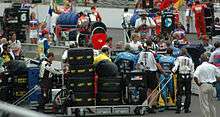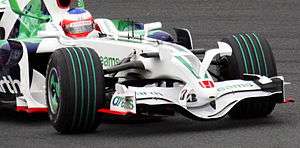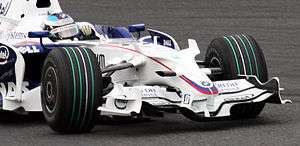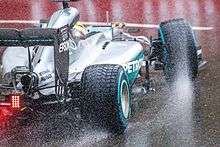Formula One tyres
Formula One tyres play a significant role in the performance of a Formula One car. The tyres have undergone major changes throughout the history of Formula One, with different manufacturers and specifications used in the sport.
| Formula One |
|---|
|
Current season |
|
Lists |
|
Records |
Design and usage
Formula One tyres bear only a superficial resemblance to a normal road tyre. Whereas the latter has a useful life of up to 80,000 km (50,000 miles), the tyres used in Formula One are built to last less than one race distance. The purpose of the tyre determines the compound of the rubber to be used. In extremely wet weather, such as that seen in the 2007 European Grand Prix, the F1 cars are unable to keep up with the safety car in deep standing water due to the risk of aquaplaning. In very wet races, such as the 2011 Canadian Grand Prix, the tyres are unable to provide a safe race due to the amount of water, and so the race can be red flagged. The race is either then stopped permanently, or suspended for any period of time until the cars can race safely again.
History
During the 1950s and 1960s, Formula One tyres were supplied by Dunlop, Firestone, Continental and Goodyear. In 1958, Dunlop introduced its R5 racing tyre, replacing the cotton fabric of the earlier R1 to R4 tyres with nylon fabric, allowing for a reported 12 lb reduction in tyre weight.[1] During the 1960s, Dunlop introduced improved nylon casings, reduced aspect ratio, significantly increased tyre width, and the use of synthetic rubber.[1]
Slick tyres were introduced to Formula One by Firestone at the 1971 Spanish Grand Prix.[2] 1975's Ferrari 312T utilised a Goodyear 26.0"x16.2"-13" slick tyre (overall diameter x width) in the rear on a 13"x18" rim, with a Goodyear 20.0"x9.2"-13" slick tyre in the front on a 13x10" rim.[3]
For the 1981 season the maximum diameter of the rear tyre was reduced to 26.0", while the diameter of the front tyres was increased. Therefore from 1981 until 1992, Goodyear supplied white sidewall marked Eagle tyres with the sizes of 25.0"x10.0"-13" in the front and 26.0"x15.0"-13" in the rear.[4] For the 1993 season, the complete wheel width of the rear was reduced from 18" to 15",[5] prompting Goodyear to change to yellow sidewall markings to correspond to the new, narrower rear tyres which were approximately 12.8" wide, down from the previous 15.0".
For the 1997 F1 season, Bridgestone joined Goodyear in supplying tyres to F1 competitors, creating a competition between the two manufacturers.
In 1998 grooved tyres were introduced with three grooves in the front tyres and four grooves in the rear tyres.[6] Between 1999 and 2008, regulations required the tyres to feature a minimum of four 14 mm (0.55 in) grooves in them, with the intention of slowing the cars down (a slick tyre, with no indentations, is best in dry conditions).[7][8] They could be no wider than 355 mm (14 in) at the front and 380 mm (15 in) at the rear, and the maximum diameter was 660 mm (26 in), or 670 mm (26.4 in) for wet tyres.[9]
In 2005, tyre changes were disallowed in Formula One, therefore the compounds were harder as the tyres had to last the full race distance of around 300 km (200 miles). Tyre changes were re-instated in 2006, following the dramatic and highly political 2005 United States Grand Prix.
For 2007, Bridgestone became the sole tyre supplier in Formula One with the withdrawal of Michelin, and introduced four compounds of tyre, two of which are made available at each race. The harder tyre (referred to as the "prime" tyre) is more durable but gives less grip, and the softer tyre (referred to as the "option" tyre) gives more grip but is less durable. Both compounds have to be used by each car during a race and the softer tyre had a painted white stripe in the second groove to distinguish between compounds. This was introduced after the first race of the season when confusion occurred because a small dot was put on the sidewall of the tyre, instead of the white stripe. Upon the reintroduction of slicks in 2009, the sidewalls of the softer tyres were painted green to indicate the difference in compound, as there were no longer any grooves in tyres. Each team must use each specification during the race, unless wet or intermediate tyres are used during the race, in which case this rule no longer applies.
Slick tyres were reintroduced at the beginning of 2009, along with aerodynamic changes intended to shift the balance towards mechanical grip in an attempt to increase overtaking.
On 2 November 2009, Bridgestone announced their withdrawal from Formula One at the end of the 2010 season.[10][11] Michelin, Cooper Avon and Pirelli showed interest in taking over the role of tyre supplier. In June 2010, it was announced that Pirelli would be the sole tyre supplier for 2011 and would receive a three-year contract after spending three years as an official tyre supplier for both Grand-Am Rolex Sports Car Series and FIA World Rally Championship auto racing tournaments (Grand-Am Rolex Sports Car Series switched to Continental Tires and FIA World Rally Championship switch to Michelin respectively in 2011).[12] During August 2010, Pirelli commenced its test programme with the Toyota TF109 at the Mugello Circuit with Nick Heidfeld as the test driver.[13] From 2011, the feeder GP2 Series used identical Pirelli tyres as in F1.[14]
In 2009 with the removal of the 4 14 mm (0.55 in) grooves the front tyres gained proportionally larger contact patch. In 2010 the front tyres were narrowed from 270 mm (11 in) to 245 mm (9.6 in), in order to improve the balance of grip between the front and rear.[15] In 2011, with the sole tyre supplier having been changed from Bridgestone to Pirelli, the rules were the same as the 2010 season rules concerning the tyres. All teams still were required to use each type of dry tyre compound supplied in the race, and drivers that made it through to Q3 still had to use the same tyres they used to set their fastest qualifying time with to start the race. However, the way of denoting different tyre specifications was changed. Rather than a green stripe denoting a softer compound, for each tyre specification, the lettering on the tyre would have a specific colour. The hard compound would have silver lettering, the medium compound would have white lettering, the soft tyres would have yellow lettering and the super-soft tyres would have red lettering. For the wet tyres, the intermediate tyres would have light blue lettering and the full wet tyres would have orange lettering.[16]
At the 2011 Malaysian Grand Prix, Pirelli introduced a coloured band around the outside of the tyre on the softer of the two dry compounds. This was due to confusion during the first round of the season. This measure was said to be a stop gap, with a permanent solution due to be implemented at the first European race of the season. The coloured line featured at the Chinese Grand Prix too.[17] From the Turkish Grand Prix, the permanent solution was implemented; the option compound had a new marking.[18] The option tyre had two thick coloured lines between the Pirelli and P Zero logos of each tyre, which made it easier to see the colour of the marking when the tyre rotates. The prime tyre remained the same markings as previously, though later in the season had the sidewall updated with the new markings.
In 2016 new tyre rules were introduced. Pirelli will nominate 3 different compounds of slick tyres to bring to each race. Each team will have 13 sets of dry tyres for the race weekend. Of the 13 sets, two sets of tyres are chosen by Pirelli to be reserved for the race. Additionally, one set of the softest compound will be set aside for Q3. Teams are free to choose what they like for their ten remaining sets from the three chosen compounds. Each driver must use at least two different dry weather compounds during the race (including one set of the mandatory race tyres), and drivers who make it to Q3 must start the race with the tyres they set their fastest Q2 lap on. Teams must inform the FIA eight weeks before the start of a European event and 14 weeks before a non-European race their tyre choices.[19][20]
For the 2017 F1 season, significantly wider Pirelli tyres were introduced at both the front and rear axles, while the overall diameter of the tyres was increased by 10mm. Front tyre size increased to 305/670-R13 up from the previous 245/660-R13, while rear-tyre size increased to 405/670-R13 up from the previous 325/660-R13.[21] In 2017 and 2018, the FIA Formula 2 Championship continued to use the pre-2017 size Pirelli F1 tyres.
Pirelli introduced two new tyre compounds for the 2018 F1 season, Hypersoft (pink) and Superhard (orange). The Hard tyre became ice blue.[22]
Heading into the 2019 season Pirelli reduced the tyre range from seven to five dry weather compounds, they also scrapped the tyre naming system such that the tyres will denoted at each grand prix independently as hard, medium and soft with white, yellow and red sidewalls respectively rather than having a separate name and colour for each of the five tyres. The change was implemented so that casual fans could better understand the tyre system.
2005 United States Grand Prix controversy
On Friday, 17 June 2005, during the afternoon's practice session, Ralf Schumacher, who was driving for Toyota, crashed heavily in Turn 13 of the Indianapolis Motor Speedway road course, as a result of a left-rear tyre failure. Turn 13 on the Indianapolis Motor Speedway road course is a high-speed banked turn, unique in Formula One racing, that causes a greater than usual lateral load.[23] This pressure can cause the side walls of the tyre to bow and wear in abnormal places.[24]

The following day, Michelin reported that the tyres it had provided for its seven customer teams—BAR, McLaren, Red Bull, Renault, Toyota, Sauber, and Williams—were unsafe for extended high-speed use on this turn, and announced its intention to fly in another set of tyres from its Clermont-Ferrand headquarters.[25] However, the replacement tyres flown in, which were of the type used in the Spanish Grand Prix earlier that year, turned out to have the same problem when tested.[26]
In a letter to FIA Race Director Charlie Whiting, Michelin representatives Pierre Dupasquier and Nick Shorrock revealed that they did not know the cause of Schumacher's tyre failure, and unless the cars could be slowed down in Turn 13, Michelin's tyres would be unsafe and unsuitable for use during the race.[27] Whiting replied, expressing his surprise that Michelin had not brought along a second set of tyres, suggesting that the teams be informed of the maximum safe speed in Turn 13, and offered to monitor the turn by penalising any excess speed on the Michelin cars. He also addressed several solutions which had been proposed by the teams, insisting that use of the tyres flown in overnight would result in penalties, and the placement of a chicane in the turn was "out of the question"—the race would not be sanctioned by the FIA (making it a non-championship race) if the track layout was changed. He deemed the Michelin teams' proposals to be "grossly unfair" to the Bridgestone teams.[27] In a second letter, Dupasquier and Shorrock announced that they would not permit their teams to race on Michelin's tyres. The race then took place with only the three Bridgestone teams (Ferrari, Jordan and Minardi) taking part. The race was won by Michael Schumacher.
Make Cars Green campaign


At the 2008 Japanese Grand Prix the tyres had the grooves painted green, as part of a promotion by the FIA to reduce the impact of motoring on the environment, called Make Cars Green. The softer of the two types of tyre still had the second innermost groove painted white, as per normal.[28]
Upon the return of slicks at the beginning of the 2009 season the white stripe to indicate differences between the tyres was no longer possible due to the lack of grooves on the tyres. Subsequently, in a continuation of the Make Cars Green tyres in Japan, Bridgestone painted the sidewalls of the option tyre green instead.
Tyre summary

There are seven tyre compounds available for the 2020 season. Two of these are for wet weather driving, the intermediate (indicated by a green sidewall) for light standing water conditions, and the full wet (indicated by a blue sidewall) for heavy standing water. These will be available to all the teams at every Grand Prix. The remaining five tyre compounds are for dry running and are denoted C1 to C5, with C1 being the hardest tyre, meaning it provides the least grip but is the most durable, and C5 being the softest, having the most grip but being the least durable. The five tyre compounds form a sliding scale of durability and grip levels.
Pirelli will nominate three of the compounds to be run at each race. Of these three, the hardest compound will be named the hard tyre for that weekend and will be denoted by a white sidewall, while the softest compound will be named the soft and will be denoted by a red sidewall, with the third of the nominated tyres named the medium tyre which will be denoted by a yellow side wall.
The exception to this is at testing, where all five compounds are available and a different colouring system is used. C2, C3, and C4 are coloured the same as the hard, medium and soft tyres respectively, and C1 and C5 have the white and red Pirelli logo respectively with no coloured sidewall.
Pirelli designates three dry types of tyres to be used for each Grand Prix based on the circuit. Drivers are to use at least two of the dry weather compound tyres during a race, unless the race is affected by wet weather.[29]
| No. | Compound details | Tread | Driving conditions | Grip | Durability | ||||||
|---|---|---|---|---|---|---|---|---|---|---|---|
| C1 |  | Hard (White) | Slick | Dry | 5 – Least grip | 1 – Most Durable | |||||
| C2 |  | Medium (Yellow) | 4 | 2 | |||||||
| C3 |  | Soft (Red) | 3 | 3 | |||||||
| C4 | 2 | 4 | |||||||||
| C5 | 1 – Most grip | 5 – Least durable | |||||||||
| – |  | Intermediate (Green) | Treaded | Wet (light standing water) | N/A | ||||||
| – |  | Wet (Blue) | Wet (heavy standing water) | N/A | |||||||
| Source:[30] | |||||||||||
Manufacturers
From 2011 onwards, the Italian manufacturer Pirelli is the sole tyre supplier.
Past manufacturers include:
Tyre manufacturers by season
Records
Ordered by number of races won. The manufacturer which is competing in 2020 is shown in bold. These results are correct as of the 70th Anniversary Grand Prix.
| Pos | Manufacturer | Seasons[31] | Starts | Wins | Sole supplier |
First win | Last win | World Championships | |
|---|---|---|---|---|---|---|---|---|---|
| Drivers | Constr. | ||||||||
| 1 | 1964–1998 | 494 | 368 | 113[32] | 1965 Mexican Grand Prix | 1998 Italian Grand Prix | 24 | 26 | |
| 2 | 1950–1958 1981–1986 1989–1991 2011–present |
383 | 228 | 184[33] | 1950 British Grand Prix | 70th Anniversary Grand Prix | 15 | 9 | |
| 3 | 1976–1977 1997–2010[34] |
244 | 175 | 116[35] | 1998 Australian Grand Prix | 2010 Abu Dhabi Grand Prix | 11 | 11 | |
| 4 | 1977–1984 2001–2006 |
215 | 102 | 0 | 1978 Brazilian Grand Prix | 2006 Japanese Grand Prix | 6 | 4 | |
| 5 | 1950–1970 1976–1977 |
175 | 83 | 0 | 1958 Monaco Grand Prix | 1970 Belgian Grand Prix | 8 | 9 | |
| 6 | 1950–1960 1966–1975 |
121 | 49 | 11[36] | 1950 Indianapolis 500 | 1972 Italian Grand Prix | 4 | 3 | |
| 7 | 1954–1955 1958 |
13 | 10 | 0 | 1954 French Grand Prix | 1958 Argentine Grand Prix | 2 | 0 | |
| 8 | 1950–1958 | 61 | 8 | 0 | 1955 Monaco Grand Prix | 1958 British Grand Prix | 2 | 0 | |
| 9 | 1954–1958 1981–1982 |
29 | 0 | 0 | N/A | N/A | 0 | 0 | |
References
- "The Evolution of Race Tyres". Stuckey Tyres. Retrieved 17 November 2018.
- Ernst, Kurt (12 August 2013). "Montjuic, 1971: When Formula 1 met racing slicks". Hemmings Daily. Retrieved 1 May 2019.
- "Ferrari 312T - F1technical.net". www.f1technical.net. Retrieved 7 November 2019.
- "Ferrari F1 87-88 - F1technical.net". www.f1technical.net. Retrieved 17 November 2018.
- "F1 rules and stats 1990-1999". www.f1technical.net. Retrieved 6 November 2019.
- De Groote, Steven (3 July 2008). "Tyre use in Formula One". f1technical.net. Retrieved 6 December 2016.
- FIA (13 July 2007). "Formula One - Sporting Regulations - 2007" (PDF). fia.com. Fédération Internationale de l'Automobile. Archived (PDF) from the original on 29 January 2019. Retrieved 11 August 2019.
- FIA (22 February 2008). "Formula One - Technical Regulations - 2008" (PDF). fia.com. Fédération Internationale de l'Automobile. Archived (PDF) from the original on 21 October 2017. Retrieved 11 August 2019.
- FIA (11 July 2008). "Formula One - Technical Regulations - 2009" (PDF). Fédération Internationale de l'Automobile. Retrieved 21 November 2008.
- "Bridgestone to Drop Formula One Pact". The Wall Street Journal.
- English, Steven (2 November 2009). "Bridgestone to quit F1 after 2010". Autosport. Retrieved 1 May 2019.
- Staff (23 June 2010). "Pirelli tyres, adjustable rear wings among 2011 changes". Tata Communications. Archived from the original on 21 October 2012. Retrieved 24 June 2010.
- "Tyre Blog". tyreblog.co.uk. Archived from the original on 21 March 2016. Retrieved 6 December 2016.
- GMM (6 September 2010). "GP2 series to use Pirelli's F1 tyres in 2011". Motorsport.com. Retrieved 17 November 2018.
- "Règlements 2010: technique et sportif - ZoneF1.com". www.zonef1.com (in French). 2010. Archived from the original on 19 April 2016. Retrieved 11 August 2019.
- Pirelli tyres to have six different colours for 2011 Formula 1 season . Retrieved 28 March 2011
- Pirelli tweak ahead of Malaysia 7 April 2011
- "Archived copy". Archived from the original on 25 April 2011. Retrieved 28 May 2011.CS1 maint: archived copy as title (link)
- Parkes, Ian. "How the 2016 Formula 1 tyre rules will work". Autosport.com. Retrieved 3 June 2016.
- "Tyres". Formula1.com. Retrieved 10 March 2019.
- "GP2 series to use Pirelli's F1 tyres in 2011 - Formula 1 News". Retrieved 17 November 2018.
- "Pink hypersoft and orange superhard join Pirelli's 2018 tyre line-up". formula1.com. Retrieved 23 November 2017.
- Michelin: Tyres not flawed, just unsuitable. www.crash.net Archived 30 September 2007 at the Wayback Machine. Retrieved 2 December 2006
- Bridgestone take pop at Michelin over USGP '05. www.crash.net Archived 27 September 2007 at the Wayback Machine. Retrieved 2 December 2006
- Michelin looking to fly in new tyres www.-itv-f1.com Archived 29 September 2007 at the Wayback Machine. Retrieved 5 August 2006
- Stoddart comments on US Grand Prix www.motorsport.com Archived 6 June 2011 at the Wayback Machine. Retrieved 5 August 2006
- Letters between representatives of Michelin and Charlie Whiting, the FIA Formula One Race Director www.newsonf1.net. Retrieved 5 August 2006
- F1 tyres to promote 'green' push. Retrieved 8 October 2008
- "Pirelli announce tyre choices for remaining races". Formula1.com. Formula One Group. 7 October 2011. Archived from the original on 10 February 2012. Retrieved 26 January 2015.
- "F1® tires". Pirelli. 24 January 2020.
- In depth tyre manufacturers history in F1 www.statsf1.com. Retrieved 17 August 2007
- Goodyear was sole tyre supplier in F1 in 1987–1988 and 1992–1996.
- Pirelli has been the sole tyre supplier in F1 from the start of the 2011 season.
- Bridgestone provided tyres in a limited capacity at the 1976 and 1977 Japanese Grand Prix, then for the full season from 1997 through 2010.
- Bridgestone was sole tyre supplier in F1 in 1999–2000 and 2007–2010.
- Firestone was sole tyre supplier at the Indianapolis 500 races in 1950–1960.
External links
- Pirelli F1 Tyres
- FIA tyre regulation summary
- FIA tyre regulations
- Formula One Tyre Technology | Bridgestone Motorsport Official Site
- The Aerodynamic Development of the Formula One Car
- Bridgestone Teams, Single Tyre Formula And Sole Supplier
- The ATLAS Rough Guide: How to Set Up a Formula One Car (Part One)
